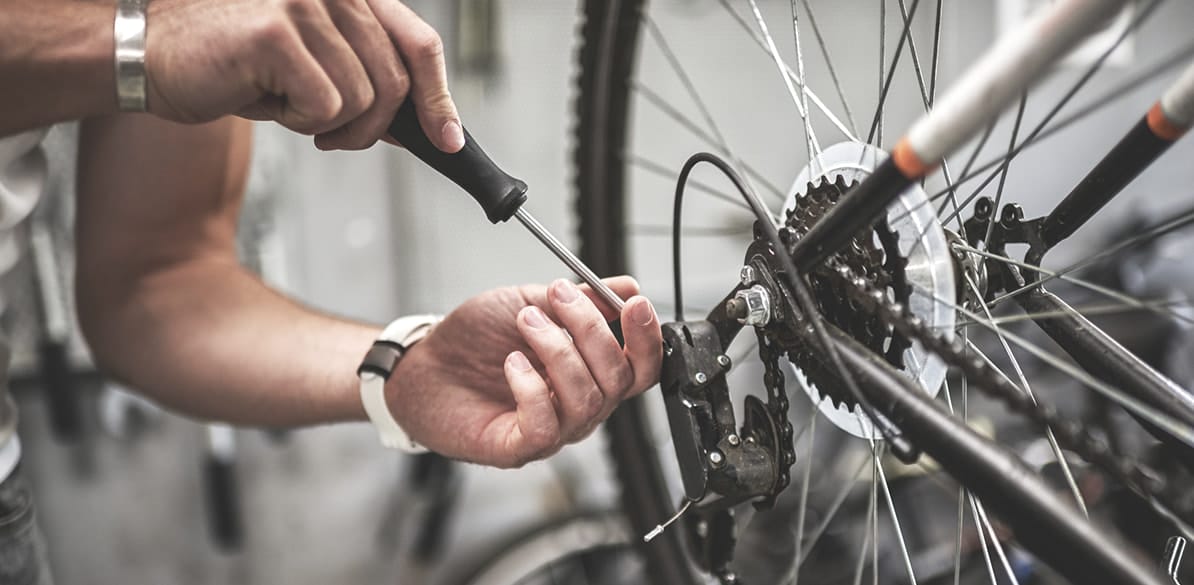Mechanisms for safer living
We explain how to keep your bike in perfect condition

Road Safety
Clearly, more complex jobs should be left to a professional mechanic, but here are a few basic and simple maintenance tasks that you can do on a regular basis to keep your bike running smoothly.
Cleaning
Water and moisture are the great enemies of your bike, as they cause the metal parts to rust and strip the lubrication from its moving parts, mainly the chain, chainrings, derailleur, and so on. That is why you should clean your bike regularly, especially the chain and the derailleur. If they are not very dirty, cleaning them with a simple rag may be enough; if there is mud or excess oil, you will have to use soap and water.
Oiling
This is essential to maintain the moving parts. You should do it every time you clean the bike with water or when you notice that it needs lubricating. You should oil the chain and chain drive system, pedals, derailleur and suspension, if any, as well as the bottom bracket, especially when you have been riding in heavy rain and mud.
Check the condition of your chain
It should be well lubricated and not suffer unnecessary friction. It is estimated that a bike chain has a long life span, ranging from 1,500 to 3,000 km. With use, the chain stretches, causing premature wear on sprockets, chainrings and derailleur pulleys, forcing you to replace them early. A simple chain gauge will let you know when the chain is stretching and needs to be replaced.
Check the brakes
You should check that the brakes are in good working order because a failure could be fatal. It is advisable to clean them and lubricate the nuts and bolts on a regular basis. You should also check the wear on the brake pads, discs and brake shoes, as appropriate. Make sure that the brake pads are not dirty or hardened, and that they do not come into contact with oils and grease, which would stop them from working properly.
Inspect the cables and check for slack
The derailleur and brake cables transmit your gear shifting and braking actions. If these do not work quickly or if the cable gets caught and does not return to its position, there is something wrong. You may be able to fix it with lubrication or you may have to go to a mechanic. In any case, make sure that the cables are not rusty and do not have any broken strands. You should also check for any play in hubs, bottom brackets and suspension fork arms, as this could cause major damage to your bike.
Check the condition and pressure of the tyres
The tyres must not have any cuts or abnormal deformations that could compromise either their behaviour or our safety. Watch out for blowouts! Check your tyre pressure before every ride.
Retighten nuts and bolts
These are often neglected, even though both elements tend to loosen due to vibrations from the road. A loose bolt (think handlebars and brakes) or an incorrectly tightened wheel nut could lead to a mishap. That’s why it doesn’t hurt to at least check the tightness of the stem, handlebar and saddle bolts as well as the wheel nuts before every ride.
And what special precautions should you take when cleaning your E-Bike?
Firstly, you should remember that you must not tamper with the engine or the various electronic components. Leave this task to a specialist. But you can take care of your battery by using the original battery charger and following the manufacturer’s instructions. It is advisable not to let the battery run down completely or leave it plugged in for several days at a time.
To avoid the risk of fire during the battery charging process, you must always use the original charger, never tamper with the battery charge and power control system, replace the battery with original spare parts or have it repaired by experienced professionals, and ask one of these professionals to check any batteries that may have suffered a major impact or deformation.
If you are not going to use the E-Bike for a long period of time, it is wise not to leave the battery completely discharged. Preferably keep it above 30% charge, and try and recharge it at least every three months. Similarly, it should be stored in a dry place with a stable temperature of between five and twenty degrees Celsius.
The other parts of the E-Bike require similar maintenance to conventional bikes, except for cleaning, which requires greater care given the existence of electronic components. Once the battery has been removed and the rest of the sensitive elements, such as screens, speed sensors, navigator, etc., have been properly protected, you can clean it following the manufacturer’s recommendations.
